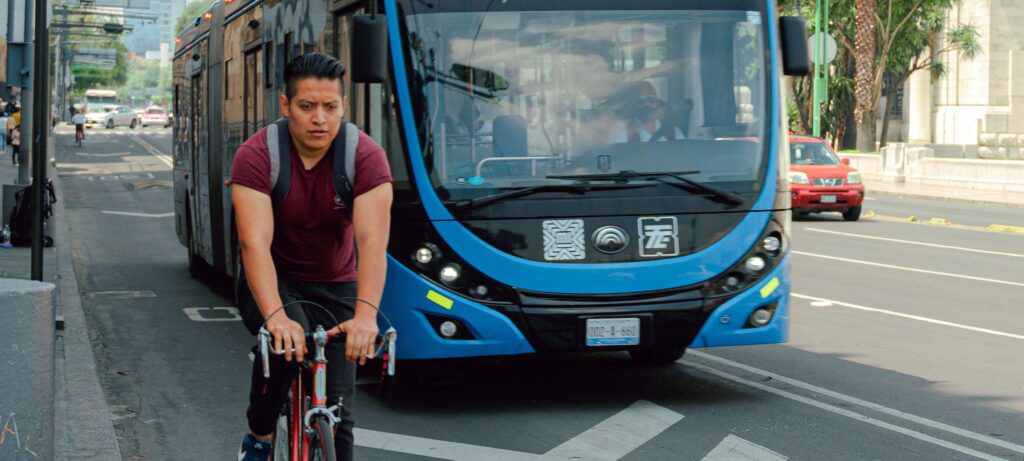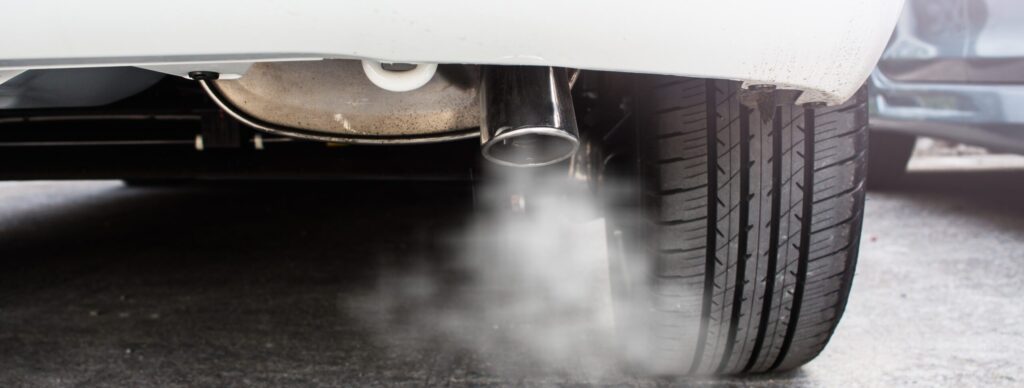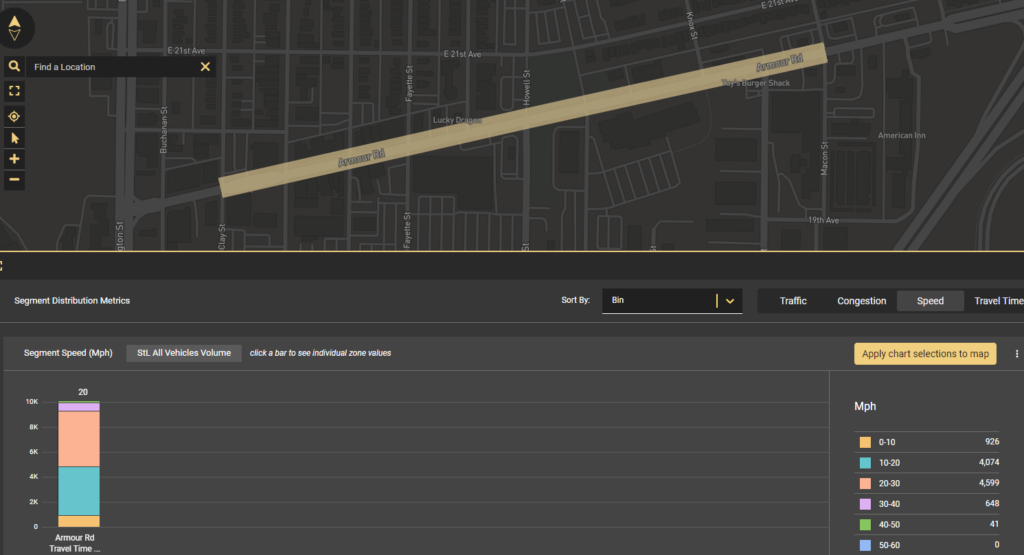
Jump Ahead

In the United States, transportation planning goals and existing road design are often out of sync. In many U.S. cities, roads were built first for vehicles, with little thought given to other types of transportation.
This imbalanced approach has far-reaching effects, impacting public health and well-being in many ways. In 2022, there were over 7,600 pedestrian deaths in the U.S., more than 17% of all traffic-related fatalities. [1] Meanwhile, the transportation sector is responsible for more than 25% of all pollution-related deaths each year. [2] Not only that, but the existing road infrastructure in many cities fails to account for the 9% of U.S. households that don’t have a car [3] or the 45% of Americans who lack access to public transportation. [4]
Solving these problems requires a different approach to transportation. Instead of putting the majority of public and private resources into one mode of transportation (i.e., vehicles), cities can expand multimodal options, investing in infrastructure that supports a wide range of transportation modes, from public transit to pedestrian traffic. By shifting to multimodal transportation, we can make our roadways safer and more accessible for all — and move the needle in the fight against climate change.In this post, we’ll cover:
- Multimodal transportation definition
- Multimodal vs. intermodal transportation
- Benefits of multimodal transportation systems
- Building complete streets
- Understanding multimodal movement through data
What Is Multimodal Transportation?
In one sense, the definition of multimodal transportation is straightforward: It’s an approach to transport that incorporates all modes people use to get around. These may include:
- Automobiles
- Commuter railways
- Buses
- Bicycles
- Walking
- Micromobility modes such as e-bikes and scooters
A fully multimodal transportation system features not only roadways that can support a variety of transport methods, but also a well-integrated public transit system. In other words, the entire mobility infrastructure must be designed to support a variety of ways for people to get around, along with easy commuter access to public transit and ease of transition between modes.
For example, when placed near every bus stop or subway access point, sidewalks and crosswalks can enhance safety and accessibility for cyclists and pedestrians. Public transit can also be designed to allow for easy transportation of bikes, and transit stations equipped with benches and shelter. Many American cities lack these infrastructural features, instead featuring mostly multilane roads without bike lanes, few crosswalks, open-air transit stops, and lots of land dedicated to vehicle parking lots.

Multimodal vs. Intermodal Transportation
A fully multimodal system is also intermodal, meaning that it facilitates a seamless flow of commuters across the various methods of transit. It also prioritizes pedestrians and other non-vehicle commuters in a way our current systems often do not.
For instance, if someone wants to visit the grocery store or the barber, intermodal design makes it possible for that person to safely choose non-vehicle options for getting there, such as walking or biking. If the trip is far, it might also ensure that person can easily bike to the nearest bus stop, bring their bike onto the bus, and then safely disembark and securely park their bike at their destination.
In a city that prioritizes intermodal design, a commuter can easily look up public transit stops and schedules online or on a mobile app. They can even find available e-bikes in the same app and plan their route accordingly. In one fluid process, they can walk to the e-bike, rent it, ride to the bus stop, wait in shelter and safety, and get to their destination on time, regardless of where they live or their socioeconomic status. True multi- and intermodal transportation systems dissolve the boundaries between different modes of travel.
While this vision is far from realized in any American city today, there are encouraging signs of transformation. While denser cities like New York and Chicago are frequently cited, Memphis also offers a promising model for more typical American cities. Memphis city planning agencies have invested heavily in multimodal transportation, such as bike paths, carpool lanes, trolleys and even water taxis. [5] These investments have also positioned Memphis as one of America’s leading cities for freight and logistics operations. [6]
The Benefits of Multimodal Transportation Systems
Transitioning to a multimodal transportation system brings a wide range of advantages, but we can summarize them in terms of their equity, environmental, and economic benefits.
How Multimodal Transport Is More Equitable
Multimodal transportation is more equitable than a single-mode system, both in terms of transportation access and public health.
As noted above, roughly 9% of American households have no access to a vehicle. However, that lack of access is skewed heavily toward minority communities. A full 18% of Black households lack vehicle access, for example, while the same can only be said for 6% of White households. [3] Many minority communities also find it harder to access efficient means of public transportation. In some cities, Black commuters take 25% longer than White commuters to reach their workplace destination. [7]
These inequities extend beyond race and class and also cut across age lines. One AARP study revealed that 48% of Americans over age 50 don’t have a comfortable place to wait for the bus, while 47% can’t access crosswalks to cross main roads safely. [8]
The effects of such inequities are multifaceted, but perhaps none illustrates the disparity more than health outcomes. Pollution from transportation has an outsized impact on low-income communities, minorities, and young children. [9] Meanwhile, access to active forms of transportation like biking and walking has been correlated with increased physical activity, resulting in a 12% decrease in mortality and an 11% drop in cardiovascular disease. [10] Finally, deaths involving vehicles disproportionately affect pedestrians, children, older adults, and Black Americans. [11], [12]
An equitable approach to multimodal transportation directly confronts these disparities by providing safe, easy, and affordable access to a wide range of transportation types.
Get the data behind safer streets for all modes and all road users
Download Safety HandbookHow Multimodal Transport Helps the Environment
Poor air quality from pollution results in 100,000–200,000 annual deaths in the U.S. [13] However, the transportation sector’s effects on air quality extend beyond immediate public health concerns to threaten the environment as a whole. Currently, transportation accounts for 29% of all greenhouse gas (GHG) emissions in the U.S., more than any other sector. [14]
On a global scale, the United Nations has set a target of a 50% reduction in transportation-related carbon dioxide emissions by 2050, citing this as a critical target to help reach larger goals for mitigating climate change. [15] While many of these initiatives focus on the transition to electric vehicles — and they should — there is also a case to be made for a broader focus on multimodal transportation.
For instance, one study showed that cyclists produced 84% fewer greenhouse gas emissions than those who used cars or public forms of transit. [16] Making cycling, walking, and e-mobility more accessible and safe could have a substantial effect on GHG emissions. Even moving more Americans from cars to public transit would go a long way.

How Multimodal Transport Boosts Economic Prospects
It’s no secret that automobiles are expensive. Depreciation, maintenance, and rising fuel expenses are all costs of ownership, and the purchase price of vehicles has risen steadily in recent years. [17] On top of that, today’s high interest rates make financing a car an even more costly proposition.
One of the simplest solutions to this cost burden is to make cars less of a necessity. When more Americans can choose alternative forms of transportation, they can allocate less of their budget toward getting around. For instance, shifting from vehicle to public transportation would save the average American $13,000 a year, according to the American Public Transportation Association. [18]
However, a multimodal system does more than simply reduce expenses — it also creates an onramp for upward economic mobility. Studies have shown a strong correlation between shorter commute times and economic mobility. [19] Yet, many high-paying jobs or better opportunities remain out of reach for low-income and minority communities, simply because the commute is too long and costly. By expanding access to efficient and affordable public transport, adding more forms of micromobility, and making transit stops easier to reach by bike, multimodal systems can help to bring these jobs within reach.
This impact extends beyond individual citizens to impact the local economy as a whole. Although more research is needed to secure concrete data, numerous studies have shown positive impacts on local business revenues when cities invest in making their roads more pedestrian- and bike-friendly. [20]
Building Complete Streets
Ultimately, to advocate for multimodal transportation is also to advocate for what are known as “Complete Streets.” Although true multimodal logistics and planning must account for more than just street design, no multimodal system is sufficient without considering this critical component.
A Complete Streets approach considers accessibility and safety from every angle when it comes to street layout. From adding bike and bus lanes to upgrading traffic signals for the visually impaired, Complete Streets policies aim to make roadways safe and user-friendly for everyone.
Designing Complete Streets has been shown to slow down traffic even without substantially increasing congestion. For instance, one StreetLight study of a bike lane installation in North Kansas City, Missouri, showed that the bike lanes nearly eliminated traffic traveling over 40 miles an hour while only increasing the average vehicle trip by five seconds.

Understanding Multimodal Movement Through Data
Effectively implementing a multimodal transportation plan always begins with understanding the current traffic patterns and modes of transportation in your area — and data access is essential for that understanding. What percentage of people use vehicles as opposed to public transit, cycling and walking? How many of the cars on the road are electric? Where is public transit readily accessible? Data offers answers to these important questions.
For example, when a Vancouver transit agency, TransLink, needed to gain political buy-in for investments in multimodal infrastructure, they combined StreetLight’s vehicle volumes data with their own ridership counts to show that bus usage was much higher than previously understood, helping them make the case for new bus lanes and rapid bus lines.
Transportation data can also help evaluate existing multimodal infrastructure for equitable impact. For instance, in the video below, Alex Bell of Renaissance Planning explains how they used StreetLight’s multimodal metrics to help Richmond, VA develop measures of accessibility for walking, biking, and transit modes. This data allowed them to reveal the causes and impacts of low access, including who is most underserved by existing infrastructure.
- Governors Highway Safety Association. “Pedestrian Traffic Fatalities by State.”
- Environmental Science and Technology Letters. “Reducing Mortality from Air Pollution in the United States by Targeting Specific Emission Sources.”
- National Equity Atlas. “Car access: Everyone needs reliable transportation access and in most American communities that means a car.”
- American Public Transportation Association. “Public Transportation Facts.”
- Memphis MPO. “On the Move and Growing.”
- Inbound Logistics. “Memphis: America’s Multimodal City.”
- National Renewable Energy Laboratory. “Roadblocks to Transportation Access.”
- U.S. Department of Transportation. “Multimodal Access to Public Transportation.”
- National Library of Medicine. “Traffic, Air Pollution, Minority and Socio-Economic Status: Addressing Inequities in Exposure and Risk.”
- U.S. Department of Transportation. “Physical Activity From Transportation.”
- National Highway Traffic Safety Administration. “Traffic Safety Facts.”
- Smart Growth America. “Dangerous by Design 2014.”
- ACS Publications. “Reducing Mortality from Air Pollution in the United States by Targeting Specific Emission Sources.”
- U.S. Environmental Protection Agency. “Fast Facts on Transportation Greenhouse Gas Emissions.”
- United Nations Economic Commission for Europe. “Climate Change and Sustainable Transport.”
- ScienceDirect. “The climate change mitigation effects of daily active travel in cities.”
- Consumer Reports. “Cars Are Expensive. Here’s Why and What You Can Do About It.”
- American Public Transportation Association. “New APTA Report Says Public Transit Users Can Save $13,000 Annually.”

Build safer roads with multimodal infrastructure planning
Download Safety HandbookReady to dive deeper and join the conversation?
Explore the resources listed above and don’t hesitate to reach out if you have any questions. We’re committed to fostering a collaborative community of transportation professionals dedicated to building a better future for our cities and communities.